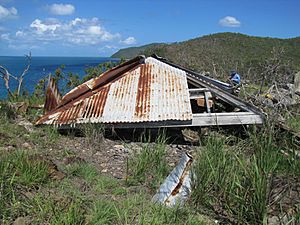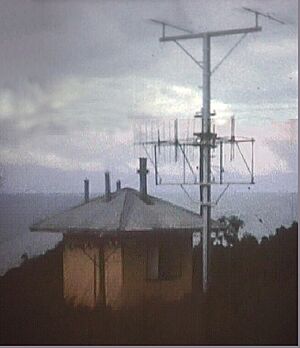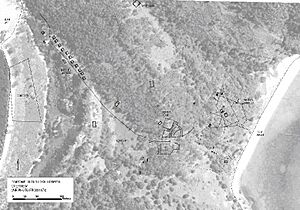Fantome Island Lock Hospital and Lazaret Sites facts for kids
Quick facts for kids Fantome Island Lock Hospital and Lazaret Sites |
|
|---|---|

Collapsed signal hut at Fantome Island, 2011
|
|
| Location | Fantome Island, Palm Island, Aboriginal Shire of Palm Island, Queensland, Australia |
| Design period | 1919 - 1930s (interwar period) |
| Built | 1926-1945 |
| Official name: Fantome Island Lock Hospital and Lazaret Sites (former) | |
| Type | state heritage (built, archaeological, landscape) |
| Designated | 8 June 2012 |
| Reference no. | 602798 |
| Significant period | Lock Hospital (1928-45); Lazaret (1939-73) |
| Significant components | artefact field, grave surrounds/railings, burial/grave, dam/reservoir, tank stand, pathway/walkway, slab/s - concrete, wall/s - stockade/pallisade, tank - water, building foundations/ruins, artefact field, track, grave marker, well, flagpole/flagstaff, grotto, building foundations/ruins, tank - water, pump, hut/shack, cemetery, pathway/walkway, slab/s - concrete, tank - storage |
| Builders | Queensland Government |
| Lua error in Module:Location_map at line 420: attempt to index field 'wikibase' (a nil value). | |
Fantome Island Lock Hospital and Lazaret Sites are important historical places. They are located on Fantome Island, which is part of the Palm Island group in Queensland, Australia. From 1928 to 1973, these sites were used to isolate Aboriginal, Torres Strait Islander, and South Sea Islander people. They were sent here if they had certain illnesses or were considered to need "protection" by the government. The Queensland Government built these facilities between 1926 and 1945. Today, they are recognized on the Queensland Heritage Register as a significant part of history.
Contents
Fantome Island's Past
Fantome Island is about 22 kilometres (14 mi) off the coast of Queensland. It is near Ingham and 6.5 kilometres (4.0 mi) north-west of Palm Island. The island was home to two special health facilities. One was a lock hospital, which operated from 1928 to 1945. The other was a lazaret, or leper colony, which operated from 1939 to 1973. Both places were used to keep sick people separate from others.
The traditional owners of Fantome Island are the Manbarra people. However, many people sent to Fantome and Palm Islands were from other parts of Queensland. They are now known as the Bwgcolman people. In 1925, Fantome Island was made a special reserve for Aboriginal people. This was part of the Aboriginal Protection Acts, which gave the government a lot of control over their lives.
Why Island Hospitals?
The idea of using islands for hospitals for Aboriginal people started in the early 1900s. The government wanted to keep sick people isolated. This was also part of a larger plan to control Aboriginal populations. In 1897, the Aboriginals Protection and Restriction of the Sale of Opium Act 1897 was passed. This law allowed the government to forcibly remove Aboriginal people to special reserves.
These reserves were often managed by a "Superintendent" who reported to the Chief Protector of Aboriginals. Life "under the Act" meant that Aboriginal people had many parts of their lives controlled. They could be removed for many reasons, not just illness. These reasons included being unemployed, old age, or as punishment.
Fantome Island was chosen for a hospital because it was close to the Palm Island settlement. This meant the same doctor could look after patients on both islands.
Building the Lock Hospital
Work on the lock hospital began in the mid-1920s. A large water reservoir was finished by November 1926. However, a cyclone in 1927 damaged the site. This delayed the completion of other buildings.
The lock hospital was ready by December 1927, and the first patients arrived in early 1928. It had separate wards for men and women. There were also laundries, staff quarters, and a store. A vegetable garden was grown to help feed the patients. They also caught fish, crabs, and oysters from the sea.
The number of patients grew quickly. By 1932, there were 156 patients. Sadly, many patients died each year from illnesses like tuberculosis and pneumonia.
The Lazaret for Hansen's Disease
In the 1930s, the government started looking for a place to send people with Hansen's disease, also known as leprosy. This disease was often misunderstood and feared. People believed it was highly contagious, so patients were kept very isolated.
Fantome Island was chosen for the lazaret in 1939. This was because it was already a reserve and had some facilities. The government also believed it would be cheaper to care for non-European patients here. The lazaret was built in the northern part of the island. It included huts for patients, a laboratory, and quarters for nuns who would help care for the sick.
In January 1940, 49 Aboriginal patients with Hansen's disease arrived from Peel Island. They joined 26 patients already on Fantome Island. The journey was long and difficult. The nuns of the Order of Our Lady Help of Christians helped care for the patients.
Life at the Lazaret
Life at the lazaret was challenging. There were often problems with food supply and medical care. Patients lived in small huts, and initially, men and women were not separated. Later, separate areas were created for male and female patients.
The death rate remained high, especially in the early years. Many patients died from tuberculosis. This meant that many families on Palm Island have relatives buried on Fantome Island.
Over time, new buildings were added. These included churches for both Catholic and Anglican patients. Houses were also built for married staff members.
In 1941, the lock hospital and lazaret became two separate reserves. This showed their different purposes.
Changes and Closure
By 1945, the lock hospital was no longer needed. Most patients had recovered or were transferred to Palm Island. It closed on August 31, 1945.
After World War II, there were some improvements at the lazaret. A septic system was installed, and a new school was built. Radio communication with Palm Island was also set up. Patients even had a movie plant for entertainment!
However, the patient huts were still in poor condition. They were hot in summer and cold in winter. Despite recommendations for better housing, the old huts were often just repaired.
A big change came in 1948 with the introduction of new drugs like sulphetrone. These medicines greatly improved the treatment of Hansen's disease. The death rate fell, and more patients were able to be discharged.
By the 1950s, there was growing pressure to end the policy of isolating patients. Critics argued that Fantome Island lacked proper medical facilities and care. The number of patients slowly decreased.
In 1970, the Queensland government decided to close the Fantome Island facility. By this time, new medicines meant that most Hansen's disease patients were no longer infectious. The lazaret officially closed on August 3, 1973. Most of the buildings were then burned down by the Health Department.
Today, Fantome Island is uninhabited. Palm Islanders often visit the island to fish. It remains a very important place for the descendants of those who lived and died there.
Exploring the Island's Remains
Fantome Island, also called Eumilli, is about 7.8 square kilometres (3.0 sq mi) in size. The historical sites are found in two main areas: the lazaret in the north and the lock hospital in the center. You can still see the remains of many buildings and structures today.
Lazaret Area
The lazaret remains are mostly on the low coastal areas of the northern part of the island. A main pathway connects the different parts of the lazaret.
Main Pathway and Buildings
The main lazaret pathway is about 5 metres (16 ft) wide. It starts at the northern beach and goes south for 120 metres (390 ft). Along this path, you can find the remains of important buildings.
Church Remains
The remains of St Mary's Catholic Church are next to the main pathway. You can see a large concrete pad where the church once stood. There's also a circular concrete feature with a stone monument. This monument has a cross and a plaque remembering the patients, nuns, and staff.
Hospital and Quarters
Further west are the remains of the lazaret hospital. You can see concrete pads, old timber stumps, and parts of the septic system. There are also old iron bed frames scattered around.
The sisters' quarters, where the nuns lived, are near the north beach. You can find concrete pads, old water tanks, and building rubble. There's also a small, solid cement structure. Its purpose is unclear, but it might have been a storage or fumigation shed.
The visitors' quarters are east of the sisters' quarters. Only some concrete stairs, timber stumps, and building rubble remain.
Grotto and Other Structures
East of the visitors' quarters is a grotto. It has a stone-lined path leading to a large shrine made of local stone. There's also a concrete altar decorated with shells.
You can also find the concrete platforms of the Palm Island workers' huts. These platforms have steps and show where stoves were located.
Signal Hut
On a hill overlooking the lazaret, you can see the remains of a timber-framed signal hut. The roof and walls have fallen onto the concrete floor. Nearby is an iron "I" beam, which was once a radio mast. This hut had a radio-telephone link to Palm Island.
Patient Huts and Facilities
On the south-west side of the northern peninsula are the remains of the single women's quarters. You can see concrete pads for 15 huts, arranged in rows. Each hut pad shows where a veranda was. There are also pads for communal kitchens, a dispensary, and laundry areas.
The supply center, located at the southern end of the main pathway, has remains of an office, store, sewing room, and an open-air cinema. East of this is the collapsed school house.
The single men's quarters are similar to the women's, with concrete pads for 15 huts and communal kitchens. The Anglican Church also stood here.
The married quarters are next to the single men's area. These hut pads often have an extension for a personal kitchen. There are also remains of communal kitchens and a garden area.
Water Supply and Cemetery
East of the married quarters are the remains of several wells and pumping equipment. This shows how water was supplied to the lazaret.
The lazaret cemetery is located on the southern bank of a tidal creek. It has 120 marked graves, many lined with stones. Some timber crosses still stand, but most names are gone. This cemetery is a very important place for families.
Lock Hospital Area
The lock hospital is in the central part of the island. Its remains are spread across both the eastern and western sides.
Hospital Complex
On the eastern beach, you can find the remains of the main hospital buildings. These include concrete pads, old timber stumps, and water tanks. There are also stone-lined pathways and remnants of a brick furnace. A triangular arrangement of concrete blocks suggests where a flagpole once stood.
At the southern end of the eastern beach, there are remains of a small stone dam wall in a creek.
Central Ridge
Between the eastern beach and Juno Bay (western beach) is a central ridge. Here, you can see dry stone walls that formed pens and paths. These might have been for livestock or to define living areas.
There are also concrete pads that could be the remains of staff quarters, like the assistant superintendent's and superintendent's homes. A large concrete reservoir is located in a steep gully, showing part of the island's water system.
Patient Quarters and Cemetery
On the western slope of the ridge are the remains of twelve raised concrete pads. These were the lock hospital married quarters. Each pad has a veranda. There's also a communal kitchen pad with an old iron stove.
The lock hospital cemetery is located south-west of the married quarters. It has four clearly marked graves, three with headstones. One headstone still has a readable inscription. This cemetery is also a very important site.
Why Fantome Island is Important
Fantome Island is listed on the Queensland Heritage Register for many reasons:
- Showing History: It shows how Aboriginal, Torres Strait Islander, and South Pacific Islander people were controlled and discriminated against in the past. The lazaret also shows that non-European patients were kept separate from European patients.
- Rare Heritage: The lock hospital was Queensland's only island-based lock hospital. The lazaret was one of only two in Queensland for non-European patients.
- Learning from the Past: The remains of the hospital and lazaret can help us learn more about the lives of the patients and staff. There are not many written records, so the physical remains are very valuable for understanding this history.
- Key Features: The sites show common features of such facilities. These include being on an island, having separate areas for staff and patients, cemeteries, and attempts to grow their own food.
- Strong Feelings: The beautiful but isolated setting of the island, combined with its sad history, creates a powerful feeling for visitors.
- Community Connection: Fantome Island has a very strong connection with former patients, staff, and their families. Most people on Palm Island have at least one family member buried there.
Documentary Film
A film called Fantome Island was released in 2011. It tells the story of Joe Eggmolesse, who was a patient there as a child. He returns to the island as an adult. The film also shows the history of unfair policies by the Queensland government. It has won several awards and has been shown on TV.





